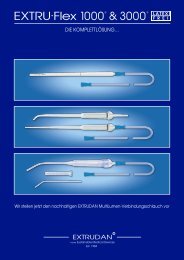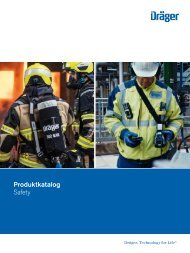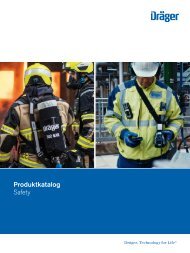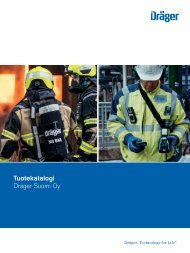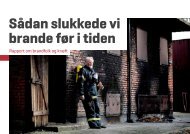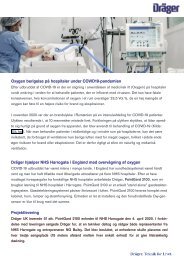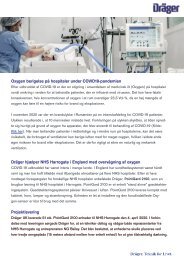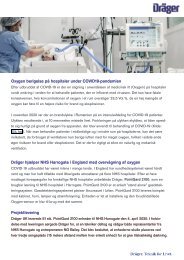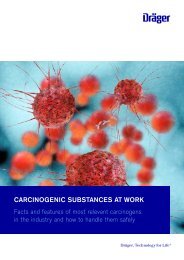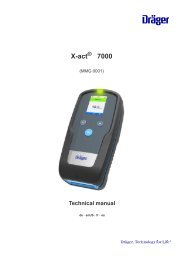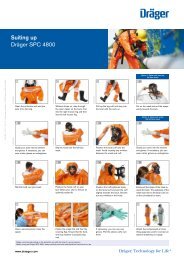OR-Brochures-BR FilterHMEs Supporting daily
Create successful ePaper yourself
Turn your PDF publications into a flip-book with our unique Google optimized e-Paper software.
MT-2909-2008<br />
Filter/HMEs: <strong>Supporting</strong> <strong>daily</strong><br />
clinical routine<br />
SAFESTAR®<br />
CARESTAR®<br />
HUMIDSTAR®<br />
TWINSTAR®
02 |<br />
MT-2759-2008<br />
Clinical Challenges<br />
The utilization of heat and moisture exchangers (HMEs) and breathing system filters in the <strong>OR</strong>, the<br />
ICU as well as other settings is an approach to address concerns commonly associated with<br />
mechnical ventilation: proper humidification of inspired air and cross-infection.<br />
Humidification<br />
Humidification of the inspired gas in mechanical ventilation<br />
has been shown to contribute to the prevention of ventilatorassociated<br />
pneumonia (VAP). 1 Passive humidification as<br />
performed by heat and moisture exchangers additionally<br />
decreases condensation and moisture accumulation in the<br />
breathing system. 1 Assessing the efficacy of HMEs in<br />
reducing bacterial growth and prevention of VAP, various<br />
randomized controlled studies observed slightly lower VAP<br />
rates, suggesting that the use of HMEs might decrease<br />
VAP rates. 2,3,4,5,6,7<br />
VAP is the most important nosocomial infection in intensive<br />
care units, accounting for 9 cases/1,000 ventilation days or<br />
about 30,000 cases annually in Germany alone. 8 VAP leads<br />
to an attributable mortality rate of up to 71 % 9 , increased<br />
average duration of mechanical ventilation 10 , increased<br />
length of hospital stay 11 , and higher treatment costs 12 .<br />
The use of HMEs may decrease not only the incidence of<br />
VAP in patients eligible for these devices, but also the<br />
associated workload and cost. 1 Late-onset VAP, occurring<br />
after five or more days of mechanical ventilation, is often<br />
due to multiresistant organisms such as Methicillin-<br />
Resistant Staphylococcus Aureus (MRSA) 13,14 or Aerobic<br />
Gram-negative bacteria such as Pseudomonas aeruginosa,<br />
the latter originating 50 % from endogenous sources and<br />
50 % from cross-contamination. 1<br />
Cross Infection<br />
As a preventive measure for infection prophylaxis and<br />
avoiding the risk of cross-infection in anesthesia, various<br />
expert committees recommend the use of a breathing<br />
system filter, to be attached to the Y-piece and replaced<br />
after every patient. 15,16,17,18
MT-1439-2008<br />
| 03<br />
In several countries national medical associations have Furthermore, the French Society of Anesthesia and<br />
already put forth guidelines recommending the utilization Intensive Care recommends the use of a hydrophobic,<br />
of breathing system filters.<br />
mechanical filter for anesthesia which withstands at least a<br />
minimum water pressure of 49 mbar. 27<br />
In its November 2002 publication “Infection Control in<br />
Anaesthesia” 15 , the Association of Anaesthetists of Great The Centers for Disease Control and Prevention in the<br />
Britain and Ireland recommends using a new breathing United States recommend the use of a breathing system<br />
system filter for each patient. There is evidence that filter during anesthesia in patients with confirmed or<br />
28, 29<br />
breathing circuits are often contaminated with transmissible suspected tuberculosis.<br />
microorganisms and blood. 19, 20 Furthermore, the possibility<br />
of cross-infection of Hepatitis C 20 and the occurrence of The Ministry of Health and Long-Term Care of the<br />
multiple-resistant tuberculosis pathogens have also been Canadian province of Ontario has constituted the use of a<br />
cited.<br />
hydrophobic, mechanical filter in all confirmed and<br />
suspected cases of SARS between the patient and the<br />
The Hygiene recommendations in anesthesia 16 by the ventilator. 30<br />
French Working Group for Hygiene in Anesthesia advise<br />
using a breathing system filter on the Y-piece and<br />
According to the Recommendations for Prevention of<br />
replacing it after every patient to prevent the risk of Nosocomial Pneumonias 18 published in Germany in 2000,<br />
possible cross-infection.<br />
by the Commission of Hospital Hygiene and Infection<br />
Prevention at the Robert Koch Institute, an anesthesia<br />
An update of these recommendations 17 in June 2002, breathing circuit with breathing system filters shall be<br />
authored by the Comité Technique National des Infections replaced once <strong>daily</strong>. If breathing system filters are not<br />
Nosocomiales, stresses the need to protect the anesthesia used, the anesthesia hoses must be replaced or<br />
circuit with a filter. This requirement was derived from disinfected for each new patient. Breathing system filters<br />
publications on cross-infections that actually occurred or should be inserted between the tracheal tube and the<br />
were considered possible during anesthesia. 21, 22, 23, 24, 25, 26 Y-piece.
| 04<br />
Bibliography<br />
1 Kola A, Eckmanns T, Gastmeier P, 2005,: Efficacy of heat and<br />
moisture exchangers in preventing ventilator-associated pneumonia:<br />
meta-analysis of randomized controlled trials, Intensive Care<br />
Medicine,31:5<br />
2 Martin C et al., 1990, Heat and moisture exchangers and<br />
vaporizing humidifiers in the intensive care unit, Chest, 97:144<br />
3 Dreyfuss D et al., 1995, Mechanical ventilation with heated<br />
humidifiers or heat and moisture exchangers: effects on patient<br />
colonization and incidence of nosocomial pneumonia,<br />
Am J Respir Crit Care Med,151:986<br />
4 Branson RD et al., 1996, Comparison of three humidification<br />
techniques during mechanical ventilation: patient selection,<br />
cost and infection considerations, Respir Care, 41:809<br />
5 Kirton OC et al., 1997, A prospective, randomized comparison<br />
of an in-line heat moisture exchanger filter and heated wire<br />
humidifiers: rates of ventilator-associated early-onset (communityacquired)<br />
or late-onset (hospital-acquired) pneumonia and<br />
incidence of endotracheal tube occlusion, Chest, 112:1055<br />
6 Boots RJ at al., 1997, Clinical utility of hygroscopic heat and moisture<br />
exchangers in intensive care patients, Crit Care Med, 25:1707<br />
7 Memish ZA et al., 2001, A randomized clinical trial to compare the<br />
effects of a heat and moisture exchanger with a heated humidifying<br />
system on the occurrence rate of ventilator-associated pneumonia,<br />
Am J Infect Control, 29:301<br />
8 Gastmeier P et al., 2003, Five years working with the German<br />
nosocomial infection surveillance system (Krankenhaus Infektions<br />
Surveillance System), Am J Infect Control, 31:316<br />
9 Powers J (2006): Managing VAP effectively to optimize outcomes<br />
and costs, Nurs Manage, 37(11):48A-48F<br />
10 Rello J et al., (2002, Epidemiology and Outcomes of Ventilator-<br />
Associated Pneumonia in a large US Database, Chest, 122:2115-21<br />
11 Kollef MH, 1999, The Prevention of Ventilator- Associated<br />
Pneumonia, N Engl J Med, 340:627<br />
12 Craven DE, 2006, Preventing Ventilator-Associated Pneumonia in<br />
Adults – Sowing Seeds of Change, Chest, 130:251-60<br />
13 Chastre J, Fagon JY, 2002, Ventilator-associated pneumonia,<br />
Am J Respir Crit Care Med, 165:867<br />
14 Cook D, 2000, Ventilator associated pneumonia, Intensive Care<br />
Med, 26:31<br />
15 Wallace PGM et al., 2002, Infection Control in Anaesthesia, The<br />
Association of Anaesthetists of Great Britain and Ireland: London<br />
16 Groupe de travail sur l’hygiène en anesthésie, 1998,<br />
Recommendations concernant l’hygiène en anesthesia, Annales<br />
françaises d'anesthèsie et de rèanimation, 10(17)<br />
17 Comité technique national des infections nosocomiales, Groupe<br />
permanent de réflexion et vigilance sur la désinfection, Sousgroup<br />
désinfection en Anesthésie Réanimation, 2002, Désinfection<br />
des dispositifs médicaux en anesthésie et en réanimation,<br />
Ministère de la santé, de la famille, et des personnes handicapées<br />
18 Kommission für Krankenhaushygiene und Infektionsprävention beim<br />
Robert Koch-Institut: Prävention der nosokomialen Pneumonie,<br />
2000, Bundesgesundheitsblatt – Gesundheitsforschung –<br />
Gesundheitsschutz, 43:302<br />
19 Miller DH et al., 2001, Presence of protein deposits on cleaned<br />
reusable anaesthetic equipment, Anaesthesia, 56:1069<br />
20 Chrisco JA, Devane G, 1992, A descriptive study of blood in the<br />
mouth following routine oral endotracheal intubation, Journal of the<br />
American Association of Nurse Anesthetists, 60:379–383<br />
21 Olds JW et al., 1972, Pseudomonas aeruginosa respiratory tract<br />
infection acquired from a contaminated anesthesia machine,<br />
Am Rev Respir Dis, 105:629<br />
22 Herwaldt LA, Pottinger J, Coffin SA, 1996, “Nosocomial infections<br />
associated with anesthesia”, in Mayhall CG (ed.), Hospital<br />
epidemiology and infection control: 655–675, Williams and Wilkins:<br />
Baltimore<br />
23 Hovig B, 1981, Lower respiratory tract infections associated with<br />
respiratory therapy and anaesthesia equipment, J. Hosp Infect,<br />
2:301<br />
24 Nielsen H et al., 1980, Cross-infection from contaminated<br />
anaesthetic equipment. A real hazard?, Anaesthesia, 35:703<br />
25 Chant K et al., 1994, Investigation of possible patient-topatient<br />
transmission of hepatitis C in a hospital, New South Wales Public<br />
Health Bulletin, 1994, 5:47<br />
26 Knoblanche GK, 1996, Revision of the anaesthetic aspects of an<br />
infection control policy following reporting of hepatitis C<br />
nosocomial infection, Anesth Intensive Care, 1996, 24:169<br />
27 Hajjar J, Loctin H, Goullet D. Technical requirements for buying a<br />
heat and humidity exchanger for ventilation during anesthesia,<br />
Annales françaises d'anesthèsie et de rèanimation, 19(7):556<br />
28 Sehulster L, Chinn RYW, 2003, Guidelines for Environmental<br />
Infection Control in Health-Care Facilities - Recommendations of<br />
CDC and the Healthcare Infection Control Practices Advisory<br />
Committee (HICPAC), MMWR 52(RR10)<br />
29 Jensen PA et al., 2005, Guidelines for Preventing the Transmission<br />
of Mycobacterium tuberculosis in Health-Care Settings,<br />
MMWR 54(RR17);1-141<br />
30 Ministry of Health and Long-Term Care, 2004, Directive<br />
to all Ontario Health Care Facilities/Settings for High-Risk<br />
Aerosol-Generating Procedures under Outbreak Conditions,<br />
Directive HR04-13
| 05<br />
Dräger Filters/HMEs -<br />
for all Clinical Applications<br />
and Needs<br />
D-297-2010<br />
D-10126-2009<br />
SafeStar® Family<br />
CareStar® Family<br />
D-10125-2009<br />
D-10127-2009<br />
HumidStar® Family<br />
TwinStar® Family
06 |<br />
The Dräger Solution<br />
The HMEs and breathing system filters of Dräger’s extensive<br />
portfolio offer the following features:<br />
– For different tidal volumes and/or different deadspace<br />
needs all products are available in different sizes<br />
– Equipped with a Luer-Lock connector for gas sampling<br />
– Sampling port in convenient 45° angle<br />
– With a tethered luer cap in order to prevent any loose<br />
parts from falling into the breathing system*<br />
– Transparent housing of the products allows for visual<br />
inspection at any time while in use<br />
– Fast and easily identified due to their color coding and<br />
clear labeling<br />
– Standardized connectors provide proper and easy<br />
connection with other components of the ventilation circuit<br />
In order to support the clincian to properly address the<br />
specific challenges, Dräger offers an extensive portfolio of<br />
high-performing HMEs and breathing system filters.<br />
SafeStar® Family<br />
The new SafeStar mechanical HEPA breathing system filters<br />
from Dräger meet high standards for infection prophylaxis<br />
in ventilation. The active medium of these mechanical<br />
filters is a hydrophobic filter membrane of coated glass<br />
fibers developed specifically for this purpose. Due to the<br />
hydrophobicity Safe Star cannot be passed by potentially<br />
contaminated fluids (e.g. blood, sputum, condensate)<br />
under normal pressure conditions of mechanical ventilation.<br />
Therefore, SafeStar can inhibit the passage of fluidborne<br />
microorganisms. Furthermore, Safe Star’s mechanical<br />
medium with very high bacterial and viral filtration efficiency<br />
rates reduces the passage of airborne microorganisms to<br />
a considerable extent. This significantly helps to reduce<br />
the risk of possible cross-infection.<br />
* for further information please refer to: Department of Health, 2004,<br />
Protecting the breathing circuit in anaesthesia, Report to the Chief<br />
Medical Officer of an Expert Group on blocked anaesthetic tubing,<br />
Department of Health Publications: London, UK<br />
CareStar® Family<br />
The CareStar breathing system filters from Dräger provide<br />
an excellent and cost-efficient alternative. Due to its highperforming<br />
electrostatic filtration medium, CareStar<br />
supports protection of the patient from potentially present<br />
microorganisms in the inspired air as well as safe-guarding<br />
the ventilator and the ventilator breathing system from<br />
airborne microorganisms that the patient exhales. This also<br />
helps to reduce the risk of possible cross-infection.<br />
HumidStar® Family<br />
The HME medium of HumidStar heat and moisture<br />
exchangers from Dräger consists of a new microporous<br />
polymer foam that was specially developed for this<br />
application and returns a high degree of heat and moisture.<br />
In addition to the HumidStars for mechanical ventilation<br />
Dräger offers the HumidStar Trach for tracheostomized<br />
patients which features an oxygen port and a safety valve.<br />
TwinStar® Family<br />
The TwinStar breathing system filters/HMEs from Dräger<br />
combine all the advantages of the CareStar and the<br />
HumidStar or the SafeStar and the HumidStar. They<br />
efficiently humidify and heat the inspired air of the ventilator<br />
dependent patient. Additionally, with their high bacterial and<br />
viral filtration efficiency rates they exceptionally sustain<br />
infection-prevention since TwinStar supports protection of<br />
the patient from potentially present microorganisms in the<br />
inspired air as well as safe-guarding the ventilator breathing<br />
system from airborne micro-organisms that the patient<br />
exhales. A highlight is the TwinStar HEPA which contains<br />
a hydrophobic filter membrane of coated glass fiber. This<br />
membrane cannot be passed by potentially contaminated<br />
fluids (e.g. blood, sputum, condensate) under normal<br />
pressure conditions of mechanical ventilation.
| 07<br />
Four families - one goal:<br />
<strong>Supporting</strong><br />
<strong>daily</strong> clincial routine<br />
MT-2783-2008<br />
MT-2840-2008<br />
MT-3219-2008<br />
MT-2864-2008<br />
SafeStar® Family<br />
CareStar® Family<br />
HumidStar® Family<br />
TwinStar® Family<br />
Dräger consumables are tested and manufactured<br />
to meet the highest standards in medical<br />
technology and their functionality is convincing.
08 |<br />
Product Overview Filters / HMEs<br />
FILTERS AND HMES<br />
Product name Filter/HME Filter/HME Filter/HME Filter/HME Filter/HME Filter/HME Filter/HME Filter Filter<br />
TwinStar® TwinStar® TwinStar® TwinStar® TwinStar® TwinStar® TwinStar® SafeStar® SafeStar®<br />
90 55 65A 25 8 10A HEPA 80 55<br />
Part no. MP01800 MP01805 MP01810 MP01815 MP01820 MP01825 MP01801 MP01785 MP01790<br />
Deadspace (ml) 90 55 65 25 8 10 55 80 55<br />
Recommended patient adult adult adult pediatric pediatric/ pediatric/ adult adult adult<br />
neonatal neonatal<br />
Recommended tidal volume (ml) 300 - 1500 300 - 1500 300 - 1500 75 - 500 30 - 200 30 - 200 300 - 1500 300 - 1500 300 - 1500<br />
Bacterial retention 1 (%) 99.999 99.999 99.999 99.999 99.9 99.9 99.9999 99.9999 99.9999<br />
Viral retention 1 (%) 99.999 99.99 99.99 99.99 99.9 99.9 99.9999 99.9999 99.9999<br />
Filtration method electrostatic electrostatic electrostatic electrostatic electrostatic electrostatic mechanical mechanical mechanical<br />
(HEPA 2 ) (HEPA 2 ) (HEPA 2 )<br />
Fluid breakthrough at (mbar) – – – – – – 151 87.5 96<br />
Moisture loss 3 (mg H 2 O/l air) 4.7 7.2 6.9 5.8 6.1 6.4 9.8 – –<br />
(@ Vt 500ml) (@ Vt 500ml) (@ Vt 500ml) (@ Vt 250ml) (@ Vt 50ml) (@ Vt 50ml) (@ Vt 500ml)<br />
Moisture output 39.3 36.8 37.1 38.2 37.9 37.6 34.2 – –<br />
(mg H 2 O/l air)<br />
Resistance (mbar) 1.0 at 30 l/min 0.9 at 30 l/min 1.1 at 30 l/min 1.3 at 15 l/min 0.6 at 5 l/min 0.4 at 5 l/min 1.3 at 30 l/min 1.4 at 30 l/min 1.3 at 30 l/min<br />
2.2 at 60 l/min 2.0 at 60 l/min 2.4 at 60 l/min 1.8 at 20 l/min 1.6 at 10 l/min 1.0 at 10 l/min 2.7 at 60 l/min 3.2 at 60 l/min 2.9 at 60 l/min<br />
3.6 at 90 l/min 3.5 at 90 l/min 4.2 at 90 l/min 2.8 at 30 l/min 3.0 at 15 l/min 1.6 at 15 l/min 4.3 at 90 l/min 5.5 at 90 l/min 4.6 at 90 l/min<br />
Maximum duration of use 24h 24h 24h 24h 24h 24h 24h 24h 24h<br />
Housing material<br />
Polypropylene Polypropylene Polypropylene Polypropylene Polypropylene Polypropylene Polypropylene Polypropylene Polypropylene<br />
transparent transparent transparent transparent transparent transparent transparent transparent transparent<br />
Housing height (mm) 81.6 78.5 89.9 72.0 50.5 58.2 85.1 81.6 81.5<br />
Housing diameter (mm) 80.0 68.5 68.5 48.1 36.8 36.8 68.5 80.0 68.5<br />
Product PVC free PVC free PVC free PVC free PVC free PVC free PVC free PVC free PVC free<br />
Latex free Latex free Latex free Latex free Latex free Latex free Latex free Latex free Latex free<br />
Weight (g) 37 28 30 18 9 9 40 47 39<br />
Sampling port Luer lock Luer lock Luer lock Luer lock Luer lock Luer lock Luer lock Luer lock Luer lock<br />
Cap of sampling port tethered tethered tethered tethered tethered tethered tethered tethered tethered<br />
Connector patient side 22M / 15F 22M / 15F 22M / 15F 22M / 15F 22M / 15F 22M / 15F 22M / 15F 22M / 15F 22M / 15F<br />
Connector machine side 22F / 15M 22F / 15M 22F / 15M 22F / 15M 15M / 8.5M 15M 22F / 15M 22F / 15M 22F / 15M<br />
Shelf life 3 years 3 years 3 years 3 years 3 years 3 years 5 years 5 years 5 years<br />
Colour code Blue Blue Blue Blue – – Blue Red Red<br />
Units/package (pcs.) 50 50 50 50 50 50 50 50 50<br />
1 According to Nelson Laboratories, Inc., Salt Lake City, USA<br />
2 According to EN 1822-1:1998<br />
3 According to ISO EN 9360-1 (2000)
| 09<br />
FILTERS AND HMES<br />
Product name Filter Filter Filter Filter HME HME HME HME HME<br />
SafeStar® CareStar® CareStar® CareStar® HumidStar® HumidStar® HumidStar® HumidStar® HumidStar®<br />
60A 45 40A 30 55 25 10A 2 Trach<br />
Part no. MP01795 MP01755 MP01765 MP01770 MP01730 MP01735 MP01740 MP01745 MP01750<br />
Deadspace (ml) 60 45 40 30 55 25 10 2 8<br />
Recommended patient adult adult adult adult/ adult pediatric pediatric/ neonatal adult<br />
pediatric<br />
neonatal<br />
Recommended tidal volume (ml) 300 - 1500 300 - 1500 300 - 1500 100 - 1500 300 - 1500 75 - 500 30 - 200 10 - 30 100 - 1500<br />
Bacterial retention 1 (%) 99.9999 99.999 99.999 99.999 – – – – –<br />
Viral retention 1 (%) 99.9999 99.999 99.99 99.99 – – – – –<br />
Filtration method mechanical electrostatic electrostatic electrostatic – – – – –<br />
(HEPA 2 )<br />
Fluid breakthrough at (mbar) 117 – – – – – – – –<br />
Moisture loss 3 (mg H 2 O/l air) – – – – 6.3 6.2 6.4 6.4 10.8<br />
(@ Vt 500ml) (@ Vt 250ml) (@ Vt 50ml) (@ Vt 50ml) (@ Vt 500ml)<br />
Moisture output – – – – 37.7 37.8 37.6 37.6 33.2<br />
(mg H 2 O/l air)<br />
Resistance (mbar) 1.5 at 30 l/min 0.7 at 30 l/min 1.0 at 30 l/min 0.6 at 30 l/min 0.4 at 30 l/min 0.2 at 15 l/min 0.1 at 5 l/min 0.5 at 5 l/min 0.2 at 30 l/min<br />
3.2 at 60 l/min 1.7 at 60 l/min 2.2 at 60 l/min 1.5 at 60 l/min 1.0 at 60 l/min 0.3 at 20 l/min 0.2 at 10 l/min 1.1 at 10 l/min 0.3 at 60 l/min<br />
5.4 at 90 l/min 3.2 at 90 l/min 3.7 at 90 l/min 2.6 at 90 l/min 2.1 at 90 l/min 0.4 at 30 l/min 0.3 at 15 l/min 1.9 at 15 l/min 0.2 at 90 l/min<br />
Maximum duration of use 24h 24h 24h 24h 24h 24h 24h 24h 24h<br />
Housing material<br />
Polypropylene Polypropylene Polypropylene Polypropylene Polypropylene Polypropylene Polypropylene Polypropylene Polypropylene<br />
transparent transparent transparent transparent transparent transparent transparent transparent transparent<br />
Housing height (mm) 93.1 65.1 78.4 67.1 78.5 72.0 58.2 36.6 29.6<br />
Housing diameter (mm) 68.5 80.0 68.5 68.5 68.5 48.1 36.8 19.0 34.0<br />
Product PVC free PVC free PVC free PVC free PVC free PVC free PVC free PVC free PVC free<br />
Latex free Latex free Latex free Latex free Latex free Latex free Latex free Latex free Latex free<br />
Weight (g) 42 29 25 23 28 18 9 3.5 4.5<br />
Sampling port Luer lock Luer lock Luer lock Luer lock Luer lock Luer lock Luer lock – O 2 port<br />
Cap of sampling port tethered tethered tethered tethered tethered tethered tethered – –<br />
Connector patient side 22M / 15F 22M / 15F 22M / 15F 22M / 15F 22M / 15F 22M / 15F 22M / 15F 15F 15F<br />
Connector machine side 22F / 15M 22F / 15M 22F / 15M 22F / 15M 22F / 15M 22F / 15M 15M 15M –<br />
Shelf life 5 years 3 years 3 years 3 years 5 years 5 years 5 years 5 years 5 years<br />
Colour code Red Red Red Red Green Green – – –<br />
Units/package (pcs.) 50 50 50 50 50 50 50 50 50<br />
1 According to Nelson Laboratories, Inc., Salt Lake City, USA<br />
2 According to EN 1822-1:1998<br />
3 According to ISO EN 9360-1 (2000)
HEADQUARTERS<br />
Drägerwerk AG & Co. KGaA<br />
Moislinger Allee 53–55<br />
23558 Lübeck, Germany<br />
www.draeger.com<br />
REGION EUROPE CENTRAL<br />
AND EUROPE N<strong>OR</strong>TH<br />
Dräger Medical GmbH<br />
Moislinger Allee 53–55<br />
23558 Lübeck, Germany<br />
Tel +49 451 882 0<br />
Fax +49 451 882 2080<br />
info@draeger.com<br />
REGION EUROPE SOUTH<br />
Dräger Médical S.A.S.<br />
Parc de Haute Technologie d’Antony 2<br />
25, rue Georges Besse<br />
92182 Antony Cedex, France<br />
Tel +33 1 46 11 56 00<br />
Fax +33 1 40 96 97 20<br />
dlmfr-contact@draeger.com<br />
REGION MIDDLE EAST, AFRICA,<br />
CENTRAL AND SOUTH AMERICA<br />
Dräger Medical GmbH<br />
Branch Office Dubai<br />
Dubai Healthcare City<br />
P.O. Box 505108<br />
Dubai, United Arab Emirates<br />
Tel + 971 436 24 762<br />
Fax + 971 436 24 761<br />
contactuae@draeger.com<br />
REGION ASIA / PACIFIC<br />
Draeger Medical South East Asia Pte Ltd<br />
25 International Business Park<br />
#04-27/29 German Centre<br />
Singapore 609916, Singapore<br />
Tel +65 6572 4388<br />
Fax +65 6572 4399<br />
asia.pacific@draeger.com<br />
REGION N<strong>OR</strong>TH AMERICA<br />
Draeger Medical, Inc.<br />
3135 Quarry Road<br />
Telford, PA 18969-1042, USA<br />
Tel +1 215 721 5400<br />
Toll-free +1 800 437 2437<br />
Fax +1 215 723 5935<br />
info.usa@draeger.com<br />
Manufacturer:<br />
Dräger Medical GmbH<br />
23542 Lübeck, Germany<br />
The quality management system at<br />
Dräger Medical GmbH is certified<br />
according to ISO 13485, ISO 9001<br />
and Annex II.3 of Directive<br />
93/42/EEC (Medical devices).<br />
90 66 151 | 12.10-4 | Marketing Communications | GM | LSL | LE | Printed in Germany | Chlorine-free – environmentally compatible | Subject to modifications | © 2010 Drägerwerk AG & Co. KGaA




